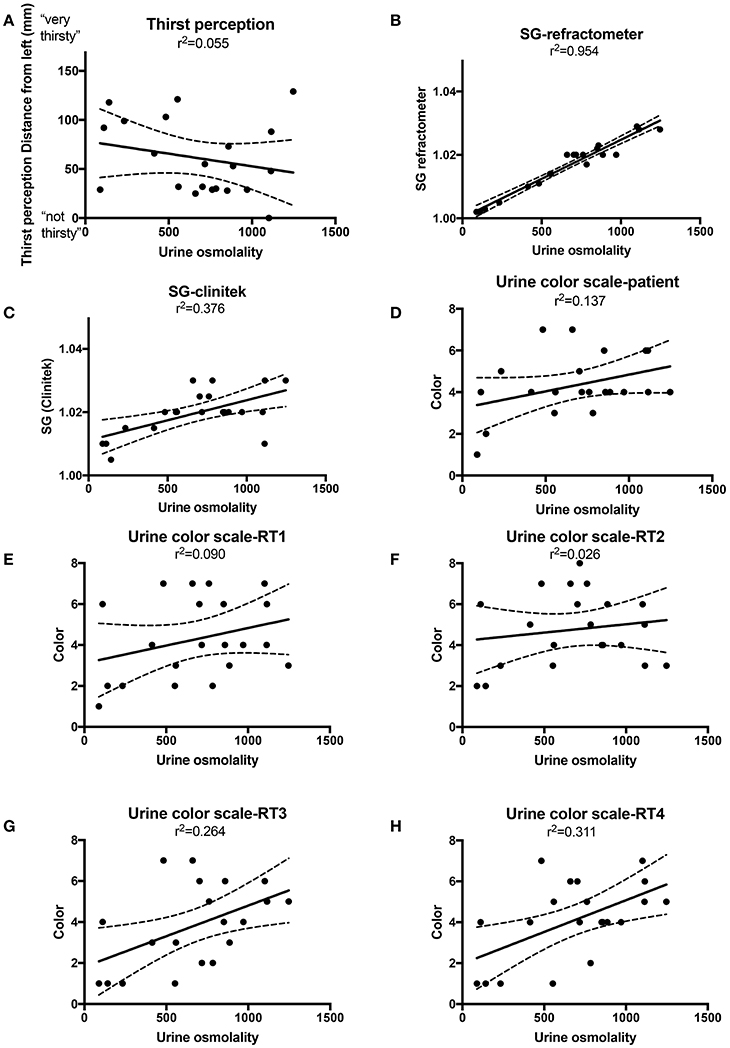

The relationship between urine osmolality and specific gravity. Replacing creatinine measurements with specific gravity values to adjust urine cotinine concentrations. Research focused on elucidating the factors affecting accurate assessment of hydration status appears warranted. Haddow JE, Knight GJ, Palomaki GE, Neveux LM, Chilmonczyk BA. Hypo-osmolality in euvolemic patients should cause excretion of a large volume of dilute urine (eg, osmolality < 100 mOsm/kg < 100 mmol/kg) and specific gravity < 1.003). Euvolemic patients should also have thyroid and adrenal function tested. P(osm), Usg, and U(osm) appear sensitive to incremental changes in acute hypertonic dehydration, however, the misclassified outcomes for Usg and U(osm) raise concerns. Laboratory tests should include serum and urine osmolality and electrolytes. At the most accurate cut-off values, 1.015 and 1.020 for Usg and 700 m(osm)/kg and 800 m(osm)/kg for U(osm), only 65% of the athletes were correctly classified using Usg and 63% using U(osm). Conclusions: We concluded that in those clinical conditions, urine osmolality should always be determined and it should not be estimated based on specific gravity. Normal value ranges may vary slightly among different laboratories. The normal range for urine specific gravity is 1.005 to 1.030. Urine osmolality is a more specific and precise test for urine concentration. Using the medical decision model, sensitivity and specificity were not significant at selected cut-offs for Usg and U(osm). The urine samples obtained from patients with different clinical conditions documented that reliance on specific gravity could over- or underestimate the urine osmolality. Urine specific gravity is a laboratory test that shows the total concentration of all chemical particles in the urine. Incremental changes in P(osm) were observed as subjects dehydrated by 5% of body weight and rehydrated while Usg and U(osm) showed delayed dehydration-related changes. This investigation: 1) compared sensitivity of urine specific gravity (Usg), urine osmolality (U(osm)) and a criterion measurement of hydration, plasma osmolality (P(osm)), at progressive stages of acute hypertonic dehydration and 2) using a medical decision model, determined whether Usg or U(osm) accurately reflected hydration status compared to P(osm) among 51 subjects tested throughout the day. Duplication for commercial use must be authorized in writing by ADAM Health Solutions.To reduce the adverse consequences of exertion-related and acute intentional dehydration research has focused on monitoring hydration status. Links to other sites are provided for information only - they do not constitute endorsements of those other sites. A licensed physician should be consulted for diagnosis and treatment of any and all medical conditions. As no hydration index has been shown to be valid in all circumstances, value exists in exploring novel biomarkers such as salivary osmolality (Vosm). The information provided herein should not be used during any medical emergency or for the diagnosis or treatment of any medical condition. Background/objectives: Hydration state can be assessed via body mass change (BM), serum and urine osmolality (Sosm, Uosm), urine-specific gravity (Usg) and urine volume (Uvol).

This site complies with the HONcode standard for trustworthy health information: verify here. Learn more about A.D.A.M.'s editorial policy editorial process and privacy policy. is among the first to achieve this important distinction for online health information and services. follows rigorous standards of quality and accountability. is accredited by URAC, for Health Content Provider (URAC's accreditation program is an independent audit to verify that A.D.A.M.


 0 kommentar(er)
0 kommentar(er)
